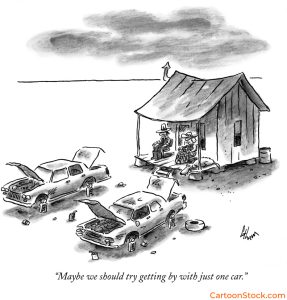
Cartoon critics Phil Witte and Rex Hesner look behind the gags to debate what makes a cartoon tick. This week our intrepid critics take a look at Cars.
The proliferation of cars has been a hallmark of modern society for over a century. They represent freedom and adventure, and reflect the personalities and values of their owners. As a ubiquitous feature of everyday life, cars are a natural subject of cartoons.
Buying a car is a stressful situation, often pitting an aggressive salesperson against a gullible mark, er, buyer. The two figures in Leo Cullum’s car lot scene are a study in contrasts: loud versus subdued clothing; exaggerated versus neutral facial expression; and an outstretched arm on a customer’s shoulder in contrast to the customer’s arms at his side. It’s a great image paired with a funny gag.
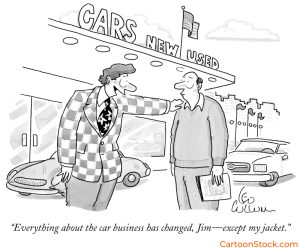
Leave it to Edward Steed for a more eccentric take on the same scenario. The artwork is untraditional to be sure, but it matches his weird and wonderful sense of humor.
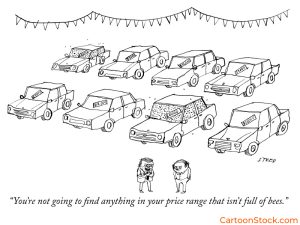
A number of cartoonists have focused on the car itself, setting it in improbable or impossible situations. A brilliant example of this approach is a cartoon by a master cartoonist, Jack Ziegler. It may take an extra moment to figure out what’s going on in this caption-less cartoon. There are several visual elements at work: people looking skyward, the apparent shadow of a car on the street, a speed bump, a discreet street sign, and, most significantly, an empty sky. Of course, the characters see more than we see, which is the key to this clever cartoon.
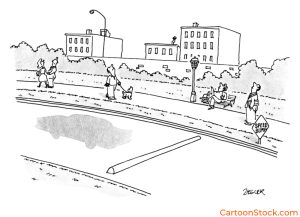
George Booth considers a similar situation and takes the opposite approach: we see what the characters do not. The caption gives new meaning to a common turn of phrase. The art is sketchy and offhand, except for the ominously inked vehicle in free fall. It’s a great cartoon that captures a moment in time.
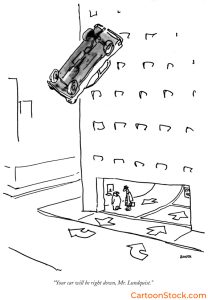
P.C. Vey belongs in the camp of cartoonists who stake their work in the realm of the weird. But within that camp, his humor is unique. You will not see one of his cartoons and think that you’ve seen something similar. The characters are familiar enough, but the gags are one-of-a- kind, like this police stop cartoon that really has nothing to do with the cop.
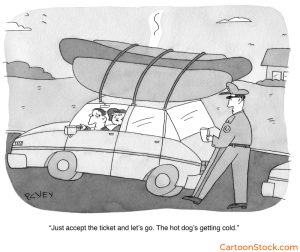
Here’s another cartoon that may require a moment of reflection before the humor hits. This finely drawn cartoon by Kaamran Hafeez relies on the old switcheroo to defy our expectations. Again, a common phrase uttered in an unlikely context is given new meaning.
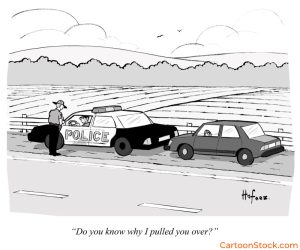
David Sipress’s caption-less cartoon has a surreal quality, featuring an inanimate object that is intent on foiling the plans of these motorists. City-dwellers can relate to how parking signs seem to conspire to prevent legal parking. Even the most cautious and law-abiding driver will somehow end up with a ticket.
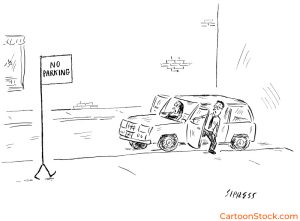
Roz Chast has a very different opinion of vehicles of any type. She’s famously neurotic and isn’t a fan of driving, so this cartoon is a natural expression of her exaggerated fears. Of course, there’s a dark truth to the cartoon. Interestingly, the landscape depicted here is barren, which may reflect her view of the world beyond New York City.
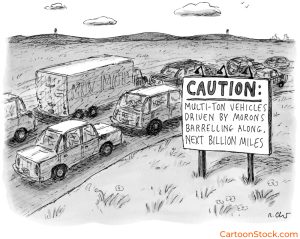
Cars, of course, take us places. Where this couple in Sam Gross’s cartoon is heading seems scary, despite the pleasant, woodsy scenery. The chirpy caption is at odds with the ominous situation. A common road sign with an uncommon message emphasizes the gag.
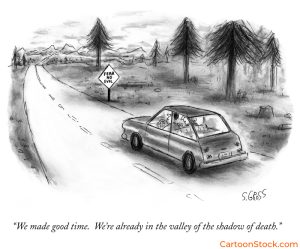
Accidents happen. The rich guy in the chauffeur-driven limo, a frequent character in Frank Cotham’s cartoons, is so removed from the hoi polloi that he sees himself as an observer, not a participant. The curious onlookers aren’t essential to the drawing, but their addition adds visual interest.
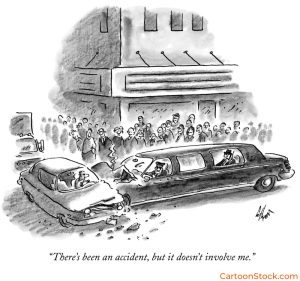
We conclude with another cartoon by Frank Cotham. The couple on the porch of their rickety shack, not strictly hillbillies because of the flat terrain, are stock characters in his cartoons, as is the long-snouted hound. Nice to see that they are thinking of downsizing. Something tells us it ain’t gonna happen.
